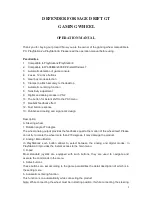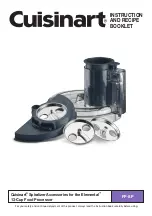
How to Use the Instrument
Description and Applications of the Test Patterns
4
4-51
Demodulator Check:
This pattern can also be used to pick up faults in other important parts of the color TV,
the demodulators. The subcarrier frequency should be applied to the R-Y and B-Y
demodulators in the correct phase; otherwise, all four squares in the third bar will contain
color.
When the phase of the subcarrier fed to a demodulator is correct, the R-Y demodulator
will only demodulate R-Y information, and the B-Y unit will only demodulate B-Y
information.
When the subcarrier frequency has a phase difference, this results in R-Y information
passing the B-Y demodulator in squares three and four. Similarly, the R-Y demodulator
could receive B-Y information. Then this will be seen as color information in squares
one and two. So a phase error in the subcarrier at both demodulators (that is, a general
phase fault) causes both to pass incorrect information. The fault shows up as a color in
all four squares.
A phase fault only related to the 90° phase-shifted subcarrier will only cause one
demodulator to pass incorrect information. This fault will cause color either in the first
two or last two squares, depending on the type of receiver.
DEM 1 (NTSC)
Figure 4-79. DEM 1 (NTSC)
DEM 1 pattern for NTSC is a B/W and color pattern comprising three horizontal bars:
•
Bar 1 consists of a standard color bar with seven colors:
White, Yellow, Cyan, Green, Magenta, Red, and Blue.
The primary color signal levels are 75/7.5/75/7.5 which equals the first part of the
SMPTE color bar.
Bar 2 of this pattern comprises two rectangles. The left-hand side contains I = -0.228
information and where the information on the Q-axis is equal to zero. On the right-
hand side Q = +0.228 information is present where the I-axis is equal to zero. With
these two areas basically the Q- and I-demodulators of NTSC equipment can be
checked.
•
Bar 3 contains white level (Y = 100 IRE) and black level (Y = 7.5 IRE). This bar can
be used to adjust contrast (difference between white level and black level) and
brightness (black level) of the picture.
Summary of Contents for 54200
Page 2: ......
Page 6: ......
Page 14: ......
Page 20: ...54200 Users Manual 1 4...
Page 28: ...54200 Users Manual 1 12...
Page 32: ...54200 Users Manual 1 16...
Page 44: ...54200 Users Manual 1 28...
Page 45: ...2 1 Chapter 2 Main Features Title Page Introduction 2 3 Main Features 2 3...
Page 46: ......
Page 50: ......
Page 142: ...54200 Users Manual 4 76...
Page 153: ...Function Reference TELETEXT 5 5 11 Figure 5 5 Position and Level of Antiope Data Lines...
Page 266: ...54200 Users Manual 6 58...
Page 292: ...54200 Users Manual 8 2...
Page 322: ...54200 Users Manual 8 32...
Page 324: ......
Page 325: ...A 1 Appendix A TV Systems Used in Various Countries...
Page 326: ...54200 Users Manual A 2...
Page 334: ......
Page 335: ...B 1 Appendix B VHF UHF Channel Frequencies for Different TV Systems...
Page 336: ...54200 Users Manual B 2...
Page 345: ...C 1 Appendix C Default Settings for Countries...
Page 346: ...54200 Users Manual C 2...
Page 348: ......
Page 349: ...D 1 Appendix D Spectras of TV Audio Systems...
Page 350: ...54200 Users Manual D 2...
Page 351: ...Spectras of TV Audio Systems Examples D D 3 Examples...
Page 352: ......
Page 353: ...E 1 Appendix E Nomenclature of Color Bar Signals...
Page 354: ...54200 Users Manual E 2...
Page 356: ......
Page 357: ...F 1 Appendix F Menu Trees...
Page 358: ......
Page 359: ...Menu Trees F F 3...
Page 360: ...54200 Users Manual F 4...
Page 361: ...Menu Trees F F 5...
Page 362: ...54200 Users Manual F 6...
Page 363: ...Menu Trees F F 7...
Page 364: ...54200 Users Manual F 8...
Page 365: ...G 1 Appendix G Pattern Popup Menus...
Page 366: ...G 2...
Page 372: ...54200 Users Manual G 8...
Page 378: ...54200 Users Manual 6...
Page 380: ...54200 54100 Users Manual Manual Supplement 1...
















































